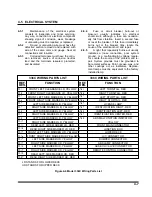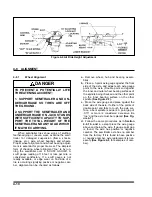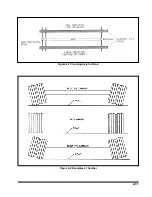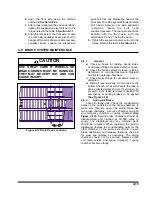
4-2 MAINTENANCE PROCEDURES
4-2.1
Repair Parts
Repair parts are illustrated and listed in a
separate parts manual. Replacement of parts due
to wear is determined by examination and meas-
urement in the Maintenance Procedures of the
section.
4-2.2
Tool and Equipment
Tools, equipment, and personnel normally
found in a facility capable of making truck repairs
will be adequate for maintenance of the semitrailer.
No other special tools or equipment should be nec-
essary.
4-2.3
Torque Values.
lists torque values for
standard hardware and is intended as a guide for
average applications involving typical stresses and
mechanical surfaces. Values are based on the
physical limitations of clean, plated, and lubricated
hardware. In all cases, when an individual torque
value is specified, it takes priority over values
given in this table. Replace original fasteners with
hardware of equal grade.
4-2.4
Cleaning
WARNING
1. PAINT THINNER AND OTHER SOL-
VENTS ARE FLAMMABLE AND TOXIC
TO EYES, SKIN, AND RESPIRATORY
TRACT. AVOID SKIN AND EYE CON-
TACT. GOOD GENERAL VENTILATION
IS NORMALLY ADEQUATE. KEEP
AWAY FROM OPEN FLAMES OR
OTHER COMBUSTIBLE ITEMS.
2. DO NOT ALLOW ALUMINUM
BRIGHTENER OR OTHER ACID COM-
POUNDS TO CONTACT HYDRAULIC
HOSES. THE HOSE COVERS ARE SUS-
CEPTIBLE TO ACID DETERIORATION.
a.
Wash semitrailer to remove all accumulated
dirt and grime. For washing aluminum use
water and a mild, non-abrasive soap or deter-
gent such as those recommended for auto-
motive finishes; or a non-etching, non-
abrasive aluminum cleaner. Use a soft cloth
or sponge. Rinse with clear water and dry
with a chamois or cloth to prevent spotting or
streaking. Wax with a liquid or paste wax rec-
ommended for the care of automotive fin-
ishes. Wax should be applied every three to
six months or more frequently if exposed to
extreme weather.
b.
Clean the sliding surfaces with solvent or
mineral spirits every six months or more fre-
quently if exposed to extreme dirt or weather
conditions. The slide wear strips are impreg-
nated with a special lubricant, however, addi-
tional lubrication may be required to prevent
chattering or squealing.
See Lubrication
Points and Specifications in Figure 4-1
and Table 4-1
.
c.
After disassembling any components, thor-
oughly clean dirt and old lubricant from all
parts. Do not use a wire brush on any bearing
parts or surfaces — use a stiff bristle brush.
Do not use compressed air, or spin bearing
parts when cleaning. These practices can
throw solvents, dirt, or metal particles into
your eyes. Dry clean parts with lint free,
clean, soft, absorbent, cloth or paper. Wash
and dry hands.
d.
Inspect seals, seal wiping surfaces, bearing
caps, and bearing cones for wear, pitting,
chipping, or other damage.
e.
Use Troubleshooting Guide to check for
“
SYMPTOMS”
AND
“PROBLEMS”
of any
semitrailer system not functioning correctly, or
where wear distortion, or breakage can be
found. Administer
“REMEDY”
according to
right-hand column of Troubleshooting Guide
(See Section 5)
.
f.
Inspect seals, seal wiping surfaces, bearing
caps, and bearing cones for wear, pitting,
chipping, or other damage.
4-4
Содержание 336C
Страница 3: ...MODEL 336C CAR CARRIER OPERATOR S MANUAL PURCHASED FROM DATE ADDRESS PHONE NO SERIAL NO...
Страница 8: ......
Страница 24: ...3 12 Figure 3 7 Lining Up the Over the Cab Deck Figure 3 8 Loading the Over the Cab Deck...
Страница 28: ...3 16 Figure 3 11 Loading the Lower Deck...
Страница 32: ...3 20 Figure 3 13 Rear Impact Guard and Antilock Brake System...
Страница 40: ...4 6 Figure 4 3 336C Wiring Diagram...
Страница 45: ...4 11 Figure 4 7 Checking Axle for Bend Figure 4 8 Examples of Camber...
Страница 50: ...4 16 Figure 4 12 Axle and Brake Assembly...
Страница 54: ...4 20 Figure 4 14 Outboard Mount Hub and Drum Figure 4 15 Inboard Mount Hub and Drum...
Страница 59: ...4 25 Figure 4 19 Mounting Tires and Wheels Figure 4 20 Stud Tightening Sequence...
Страница 70: ...NOTES 5 10...



































